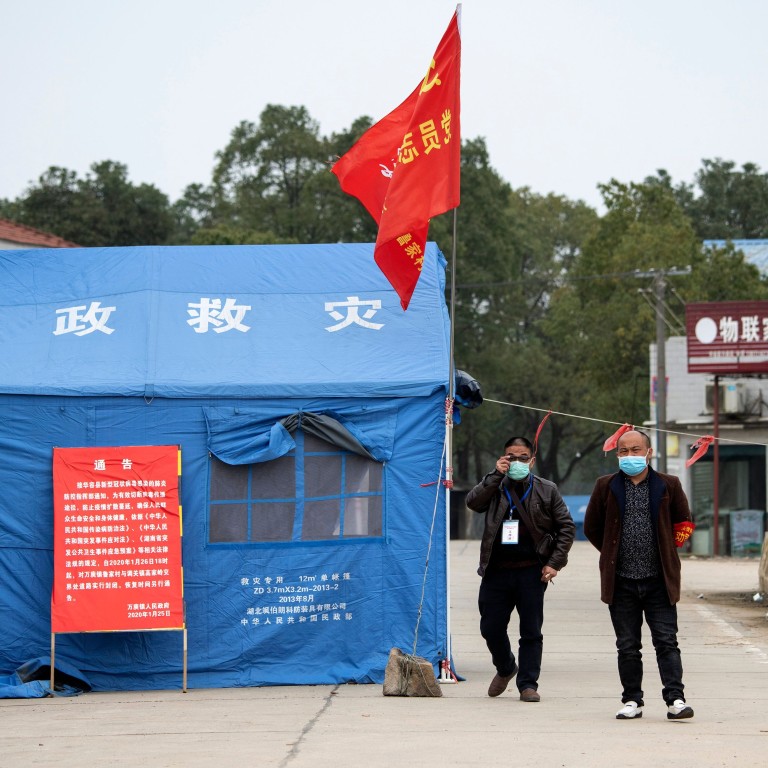
Coronavirus: Hubei city reopens for business, then closes again 30 minutes later
- Government of Qianjiang says controls on movement of people and traffic to end at 10am on Wednesday, but provincial authorities order them to be reinstated at half past
- All cities and counties in Hubei have now been given a risk classification and business is slowly returning to normal in some areas
At 8.30am on Wednesday, the government of Qianjiang – which lies about 150km (90 miles) east of Wuhan, the capital of Hubei province – said that all restrictions on the movement of people and traffic would be lifted at 10am. They were.
Then, at 10.30am, they were reinstated.
“The city will continue its restrictions on the movement of traffic and residents,” the government said, without elaborating.
About two hours later, the Hubei government issued a statement outlining the different restrictions that applied to each city within the province based on their particular situation.
And unfortunately for the people of Qianjiang, despite having the lowest number of confirmed cases of Covid-19 of any city in Hubei, the provincial authority classed it as “high risk” and ruled that all public transport would remain suspended.
It also said that only a handful of businesses in key sectors were permitted to resume their operations.
As a result, provincial leaders had ordered cities to make preparations to get their economies back in business, while rolling out a new electronic system for monitoring the public’s health.
Xi said on his visit that officials should continue to strengthen disease prevention and control measures, but where possible also get businesses back up and running.
The Qianjiang government, which was praised by some Chinese media for its swift action in implementing a citywide lockdown and other measures when the epidemic began in January, was also among the keenest to get things back to normal.
Before being overruled by the provincial authorities, the Qianjiang government told local companies they could decide for themselves when to reopen and did not have to fill in any paperwork to do so.
A district official, who gave only her surname Xiang, said Qianjiang had been harshly treated.
“[The city] did the best in Hubei in containing and controlling the outbreak. The policy was changed too fast and damaged the government’s credibility and made our work harder. The public already doesn’t trust officials,” she said.
“Everyone is at the emotional tipping point as the lockdown has lasted for more than a month. Many people have lost income because they’ve been unable to go to work. They asked us officials to give them jobs, but how can we get jobs for them in the current situation?”
Wen Kejian, a political commentator based in the east China city of Hangzhou, said the situation in Qianjiang highlighted the difficulties governments faced in trying to get their economies back online while continuing to fight the epidemic.
“Low-level officials shoulder the most pressure and have the least power. They are aware of the local situation and capable of making reasonable policies, but are subject to rulings made by their bosses,” he said.
“Although [the officials know that] the epidemic is damaging to the economy, one little slip could end their career, so most choose the more conservative options.”
Besides specific arrangements for Wuhan, Hubei’s new back-to-business guidelines classified all other jurisdictions into one of three categories based on their perceived risk level.
As of Tuesday, 45 counties and cities were classed as low risk, 19 medium risk, and 12 – including Qianjiang – high risk. Since the outbreak began, Wuhan has reported almost 50,000 confirmed cases, and Qianjiang 198.
In low and middle risk regions, construction sites, and legal and accounting firms can gradually resume operations, but businesses that involve large gatherings of people, like cinemas, shops, bars, karaoke and gyms, must remain closed for the time being.
Traffic restrictions would be gradually lifted, and public transport, including domestic flights, would be phased back in, the Hubei government said.
In Wuhan, only public utilities, agricultural firms, and companies that support the disease control effort or provide essential supplies are allowed to resume operations.
However, manufacturers considered key to national or global supply chains can also resume operations if approved to do so by the government. Japanese carmaker Honda said on Wednesday it would partially resume production at its Wuhan facility.
Additional reporting by Kinling Lo
Purchase the China AI Report 2020 brought to you by SCMP Research and enjoy a 20% discount (original price US$400). This 60-page all new intelligence report gives you first-hand insights and analysis into the latest industry developments and intelligence about China AI. Get exclusive access to our webinars for continuous learning, and interact with China AI executives in live Q&A. Offer valid until 31 March 2020.

